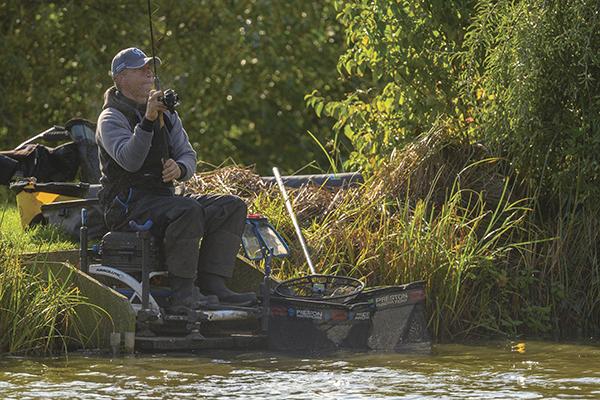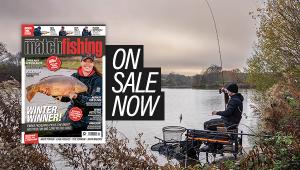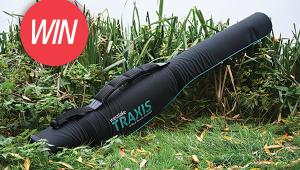The Casting King

I can’t remember the first time I went out on a feature with Andy Findlay, but it was when I was an editorial assistant on Match Fishing back in the days when Roger Mortimer was the editor. So, we’re talking 20 plus years and back then Andy was just creeping on to the commercial scene – at that time he was the man to beat at Ringstead on the River Nene. It was his success on that venue (he was unbeatable) that really put him on our radar, and we had to get him in the magazine to try and find out what he was doing differently to everybody else.
Quietly spoken and not keen on being in the limelight, Fin was a breath of fresh air and I couldn’t believe the amount of ideas he had on kit adaptations, while his knowledge of fish behaviour and how they react to bait etc was second to none.
Nothing’s changed since then. Despite the fact that fishing tackle is now more advanced and well-made than it ever has been, Fin is still adapting his gear to suit his own requirements and he’s still doing things in his own way, and that’s what makes him so successful. Whatever venue he targets, he quickly becomes THE angler to beat and since the end of lockdown it’s the anglers at the prolific Glebe complex that have suffered by being ‘finned’, where second place is as good as they can hope for when they see Fin’s van pull up in the car park!
It’s fantastic fishing too and he hasn’t had a weight lower than 120lb in matches here since the lockdown and weights can be double that on good days. The fishing is easy if you like, and anglers will all catch plenty of fish, but catching enough to win is more difficult and it’s all the small details and tricks that help Andy catch 200lb instead of 170lb, and that’s what makes all the difference.
The feeder has been a big part of his success on the venue and that will continue into the winter, so I caught up with him on Peg 23 on Lake One, where he agreed to let me into some of his tips and tricks that help him stay ahead of the competition. “The weather’s on the change now old lad,” he said as he began to unload his barrow. “We’ve had so much rain over the last few days that it’s bound to affect the fishing. We should be alright here though, as it’s one of the best areas on this lake, but after all that cold water has gone in you just never know what it’s going to be like.”
Instead of tackling up, the first thing he reached for was his flask, so I thought I’d join him and have a coffee before we got down to work. “There’s no coffee in here old lad,” he said with a big grin. “This flask has my expanders in. What I did this morning was put an ice cube in followed by water so it was about half full. Then I poured the required amount of 4mm expanders that I’d need for the session and closed the lid tight. You need to do this two hours before you use them and then you need to drain the water off and put the pellets back in the flask with just the ice cube to stop them from going any softer. This keeps the pellets firm so they don’t come off when casting.
“It’s cage feeder fishing here because the Method is banned and your hooklength needs to be at least 20 inches long, so keeping a soft bait on when casting can be tricky. I use these on venues where I fish the Method feeder too and I’m confident my expander is still on even after really crushing the pellets on hard around the feeder. It’s one trick I think keeps me ahead on here and although I don’t win every single match, I always win my lake without fail!”
One thing that always strikes me when I watch Andy, is how simple everything looks. There are never five rods and 10 top kits assembled, there’s never a bait tray crammed with as many bait boxes as it will hold filled with every bait imaginable. It’s the complete opposite with him and he will take the minimum amount of kit he can get away with, compared to every other match angler I know who will take as much kit as they can get away with! He’s so confident in what he’s doing he knows exactly what he’s going to need, or perhaps it’s more a case of what he’s not going to need?
With his box in position, which is angled slightly to the left so he’s facing into the wind, he positions the rod rest so his rod will be pretty much pointing directly at the feeder once it’s settled. “I’ve been mentioning this for years, but I’m still the only one that does this,” he began. “I think I catch more carp on the feeder than other anglers because I can cast better than them, and incorporated into that is where I place that rod rest.
“Casting accurately is the most important thing in feeder fishing for carp and I’m confident I can do it better than anyone else. I’m not being big-headed, but I see it every week and casting on the money and then getting your rod into the rest with the tightest of lines to the feeder is crucial. The way you feather the line is the art and it’s very difficult to explain, but you need the feeder to enter the water with the line tight to it, not in a bow. You have to hit the clip gently so the feeder doesn’t ping back towards, and you then lower the rod on to the rest so it’s in position with a tight line direct to the feeder immediately.
“Sometimes I might have to wind a fraction but it’s never than a half a turn and quite often I don’t even have enough slack line to get my line on to the bail arm roller. I know that by doing this I’m getting tighter to the far bank than the majority of other anglers and that catches me so many more fish!”
Obviously clipping up is crucial and Andy takes his time casting a 30g bomb across to get the right distance. “I’m using a 30g, four-hole cage feeder and when it’s full of pellets it’s obviously heavier than 30g,” he explained. “With the bomb, I need to cast slightly short of where I want to fish before clipping up to allow for the extra weight of the cage and the pellets. I’ll always have to make one or two adjustments though, when I start fishing, before I’m happy that it’s dead right.”
After clipping up, Fin replaced the bomb with his feeder and immediately I could see something was different as he tied a 3in loop in the end of his main line with a four-turn water knot for extra strength.
“You need the loop in the end of the line to double up the strength because the metal cage feeder will rub on that part of the line, and when it’s tied you need to pull it hard to make sure there are no weak spots in the line. If there are the line will break, but better it does that now than when you’ve got your first fish on.”
However, it was the feeder link that intrigued me as Fin had replaced the swivel with thick braid. “Those swivels rub against the line and damage it old lad,” he explained. “This braided link is kind to your reel line and I attach the line by creating a lasso in the loop, similar to how pole anglers will fix a rig to a dacron connector. The line pulls tight on itself and is secured in place by the knot in the braid. I also attach my 20in hooklength in the same way.
“It’s dead reliable, it’s easy to change either the hooklength or the feeder, and it doesn’t damage the line above the feeder.” How long before Preston Innovations brings that out, I thought to myself?! A braided feeder link instead of a metal snap swivel… genius!
So, Andy was all set up and ready to go but not before explaining how he prepares his micro pellets: “I don’t use any groundbait when I’m feeder fishing for carp any longer, my fishing involves pellets of various sizes. You can still catch fish using groundbait but you won’t catch as many compared to using pellets, and groundbait also tends to draw in smaller silver fish. You need carp to win matches here, so it’s pellets all the way.
“I feel I’ve perfected it over the years and I know we all have our own ways of preparing them, but here’s how I do mine. I pour half a bag into a tub and then just cover them with water, and I mean just cover them! Mine are literally covered by the width of a 2mm pellet! I then leave them to soak for two hours, but you need to turn them over two or three times in that two hours. If you do that you’ll have perfect pellets and you can see that when I press them between my thumb and finger they squash down into a smooth paste.
“There was a time when all anglers seemed to (and many still do) prepare pellets using the rule of soak for two minutes for 2mm pellets, four minutes for 4mm pellets etc. But that’s wrong because you still get hard pellets. Pellets in the feeder and pellets on the hook are all I need for catching carp because that’s what they feed on. It’s dead simple but it’s taken me 20 years of experimenting and learning to come up with the way I do it now.”
I think every angler can take a leaf out of Fin’s book because no doubt we’ve all been guilty of seriously overcomplicating things, when going back to simplicity is often the best way.
With everything set up and ready to go, Fin mounted two 4mm expanders on the hair using a Quick Stop (another of his inventions). He literally tipped around 20 pellets from his flask into a tub, because it’s important to keep them cold, so they remain ‘rubbery’ and stay on the hair during the cast. Soaking them in lake water will make them too soft for casting, according to Fin.
On to the fishing and it was a treat to see Fin cast and land the feeder so close the reeds on the far bank with amazing consistency. “It’s what you do with the rod at the end of the cast that’s most important,” he explained. “If you had a 40m tape measure the only way you could get an accurate measurement of 40 metres is if the tape was tight. Any bow in it would mean a measurement shorter than 40 metres and it’s the same with casting.
“Getting the rod on to the rest with a tight line to the feeder is so important and it’s the way you move the rod after the feeder hits the clip that ensures this. It’s not so important in deeper swims because the extra depth will get the line tight for you by the time it’s hit the bottom, but in shallow swims or when casting tight over into shallow water, that doesn’t happen – the line has to be tight as soon as the feeder hits the water.”
It’s fascinating watching Andy fish after he’s explained what he’s doing and why he’s doing it… it just all makes perfect sense. Nothing is complicated, it’s all dead simple, but it’s all been thought through and refined over many, many years of catching carp. As we expected at the start of the session, the fishing was difficult and Andy caught a few carp by loose feeding 6mm pellets at the maximum range of his catapult (around 22 metres), as well as nailing them with that deadly accurate casting towards the far bank. In match conditions, the far bank line is crucial and what he says is dead right, casting is king. If there are any better than the Fin at it, then I’ve yet to see them.
- Log in or register to post comments













